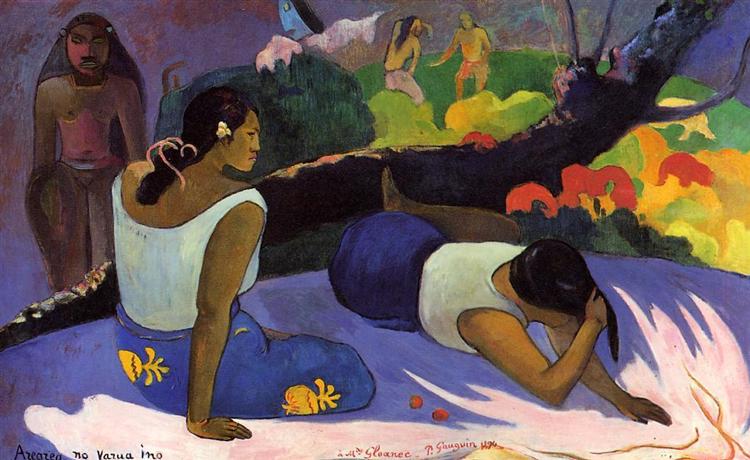Description
Paul Gauguin's painting "Reclining Tahitian Women" (1894) is a work that masterfully captures the fusion between primitivism and modernity, reflecting the artist's aesthetic evolution in his search for new forms of expression. In this painting, Gauguin presents two reclining Tahitian women in a landscape that evokes the exoticism and serenity of the island he had adopted as his home after leaving Europe. This work exhibits both the influence of his interest in Polynesian culture and his desire to break with the artistic conventions of his time.
The composition of the painting is notable for its simplicity and harmony. The main figures, two nude women, are arranged in such a way as to suggest an intimate and tranquil connection between them. The first figure, positioned further to the left, seems to be more in contact with the surface that supports her, while the second, reclining on the right, is presented at an angle that invites contemplation. Both figures are framed by a background that suggests a tropical landscape, with dense vegetation portrayed in deep green tones and textures that provide a sense of place but offer no distractions. Gauguin opts for a two-dimensional approach that contrasts with European models of spatial depth, a characteristic feature of his post-impressionist style.
The use of colour is another essential facet of this work. Gauguin employs a vibrant palette where yellow, green and blue predominate, creating an atmosphere of calm and contemplation. The shades are applied in a fluid manner, highlighting not only the beauty of the female figures, but also their connection with the natural environment. The women's skin, a warm brown tone, contrasts with the cooler colours of the background, emphasising their presence in a context that oscillates between the earthly and the spiritual. This palette not only serves to represent the Tahitian landscape, but is also a reflection of Gauguin's ideal of life on the islands, far from the industrialisation and tensions of European life.
An interesting aspect of “Reclining Tahitian Women” is how Gauguin uses the female figure as a symbol of sensuality, tranquility, and connection with nature. In his work, women are not just passive models, but embody a life in harmony with their surroundings. This representation of the female figure is recurrent in Gauguin’s work, who often idealized the women of Tahiti, creating a personal mythology that was both an aesthetic quest and a form of escapism.
Furthermore, this work fits into a broader context of Gauguin's career. During his stay in Tahiti, from 1891 to 1903, the artist produced not only "Reclining Tahitian Women," but a series of works exploring the culture and daily life of the island. Works such as "Where Do We Come From? What Are We? Where Are We Going?" and "Tahitian Women" also reflect his fascination with life in Polynesia, a source of inspiration that allowed the artist to explore themes such as identity, spirituality and human nature.
Through “Reclining Tahitian Women,” Paul Gauguin creates a space where beauty, exoticism and a wise reflection on existence converge. This work, with its balanced composition, vibrant color palette and powerful representation of the female figure, not only becomes a testament to the artist’s talent, but also a window into a world that captured his imagination, offering the viewer the opportunity to enter an alternate reality that defies the limitations of its time. In every stroke and in every color, Gauguin invites us to contemplate the very essence of what it means to be human, all framed in the splendor of Tahitian nature.
KUADROS ©, a famous painting on your wall.
Hand-made oil painting reproductions, with the quality of professional artists and the distinctive seal of KUADROS ©.
Painting reproduction service with satisfaction guarantee. If you are not completely satisfied with the replica of your painting, we will refund 100% of your money.

